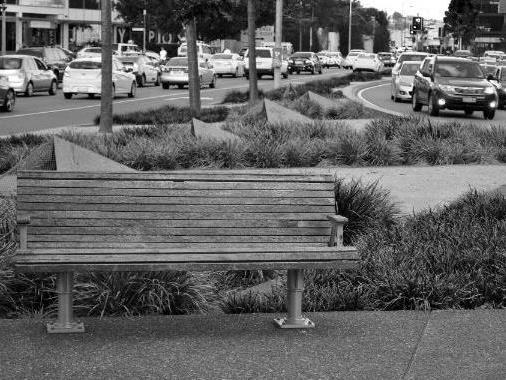There is a public chair that I pass on my way to work that adds a little melancholy to my daily commute. I have never seen anybody sit on this chair, never seen anyone occupy the space surrounding the chair, ever. Yet, every morning it’s there, fixed to its spot, lonely, waiting to offer its well meaning public service to weary legs. I don’t think this chair’s solitary condition is by any means caused by its design, materials or condition. I think it has more to do with the designer or architect who chose to place it on a traffic island, in the middle of six lanes of traffic.
I am sure that most people could list at least one or two items of street furniture in their neighbourhood that are thoughtlessly positioned. Lonely street chairs that sit in the hot sun all day, face the wrong direction, don’t pay attention the simple principles of prospect and refuge, or as in the case of my lonely chair, are almost impossible to access.
There are some very good examples of well used street furniture such as Aspect Studio’s revitalisation of Sydney’s Chinatown. This project utilised principles of site specific design to develop responsive street furniture. There is also Brisbane City Council’s Chair2Share initiative which involves moveable chairs that are freely available to the public in the city’s two main parks. It’s worth investing the time and money in developing unique and effective street furniture. Think of the identity embodied in Britain’s Red Telephone Boxes. As Gökçen Firdevs Yücel writes in his work on street furniture, ‘If street furniture is properly integrated in the design of a public space, it creates an identity and develops a sense of place around it.’
Street furniture is a public asset and councils and local authorities go to great lengths to provide guidelines on their design, locality and positioning. However, I fear that these guidelines frame a design approach that is underpinned by generalisations on ‘pedestrian patterns‘ without any real consideration given to the experience of sitting in that space. As Yücel writes, ‘being able to sit within a city landscape provides an opportunity to pause, and also a tactile and more intimate contact with a place than one has when standing or walking.’ Experience is, therefore, a critical factor in designing successful, well utilised street furniture.
Advertising and street furniture design firm JCDecaux recently collaborated with Mattieu Lehanneur on a range of innovative and interactive street furniture. In Lehanneur’s TED Talk he advocates for designers to move away from thinking of their users in the way that marketing does. Move away from focus groups and generalisations about how people interact with space and objects. Instead, he argues, that designers should embrace the way science engages with unique and complex problems. This approach, I argue, is required for good street furniture solutions. Instead of being driven by numerical ratios or measured linear distances for the positioning of street furniture, architects and designers need to consider the experience of using street furniture, for each unique and complex location and situation.
Lehanneur’s work also incorporates the use of digital environments in urban settings. This is a currently overlooked opportunity in the design of street furniture. While Brisbane City Council’s Chair2Share scheme incorporates access to WiFi, there are limited examples in Australia where the use of either portable devices or access to digital information are integrated into street furniture. This is an area of design that is in urgent need of addressing as we live in cities with increasingly dense social networks, in both physical and digital settings, that can exist simultaneously through devices such as street furniture. As Glenda Caldwell from the Queensland University of Technology’s Urban Informatic’s research group writes, ‘the world in which we live in is composed of a constant flutter between the physical and digital spaces we experience with our multiple senses and it is the memories and meanings that we attach to these spaces that create place. It is understood that place can occur either in digital or physical environments, but why not in both simultaneously?’
Street furniture has so much to offer a city – identity, places to socialise and meet and opportunities for intimate and meaningful interactions with the city. As public assets it is important that street furniture is designed with careful consideration. There are some great recent examples of site specific street furniture that have been very successful and are well utilised.
If designers and architects undertake the complex task of considering experience in the design and positioning of street furniture, instead of following arbitrarily calculated guidelines, there would be fewer lonely chairs. Street furniture also proffers an excellent nodal point for digital and urban environments to co-exist and this is a currently overlooked opportunity in Australian public spaces. With so much to do and offer to our cities, there really is no need for lonely street chairs.
